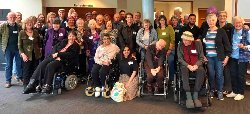DHBs work together to be Smokefree / tobacco free by 2025
Five Midland DHBs work together to be Smokefree
/ tobacco free by 2025
Monday 5 March 2012
The five Midland DHBs have combined with the Midland Iwi Relationship Board (MIRB) to renew commitment to making their central North Island districts entirely Smokefree / tobacco free by 2025.
The five DHBs; Lakes, Waikato, Taranaki, Tairawhiti, Bay of Plenty and the MIRB which represents iwi in each area, signed a refreshed Smokefree Midland vision statement committing to continue to coordinate efforts and provide strong leadership to achieve the vision on Friday 2 March 2012 in Rotorua.
“We are united in approaching this vision with a real sense of urgency. Anything less would be failing our communities because our children deserve a future where smoking is history,” said Waikato DHB chair Graeme Milne.
“Around 18 per cent of deaths in the Midland DHB areas are caused by tobacco related illnesses. This is a huge avoidable and continuing toll on individuals, families and communities.”
District health boards have statutory responsibility for improving the health of their populations. As smoking is the single biggest preventable cause of illness and early death, DHBs and MIRB must do much more to combat smoking and achieve the vision of a Smokefree / tobacco free Midland by 2025.
“Tobacco and smoking are too visible in our communities. Tobacco is a deadly addictive drug and our children need to grow up free from the risk of becoming addicted to it,” said Mr Milne.
“We are committed to working with the Government, territorial local authorities, iwi, community leaders, businesses and our communities to address this as a matter of urgency.”
Midland Iwi Relationship Board chair Punohu McCausland, says iwi health boards across the five districts are totally committed to the vision.
“For Maori, the impact of tobacco and smoking is even more significant. Eradicating smoking from New Zealand is the single most important and attainable policy action to reduce inequalities in mortality for Maori. The potential health benefits of stopping smoking for our children and our whanau are significant,” she said.
Four of the five Midland DHBs signed an initial Smokefree vision statement in 2009. They combined to recruit a Midland Smokefree Programme director to provide strategic leadership in the development of the Midland Smokefree Programme.
This year the vision statement has been updated to align with national work adding in the philosophy of being tobacco free. Taranaki DHB and the Midland Iwi Relationship Boards have also added their support to this significant collaboration.
ENDS
Smokefree Midland facts
The Smokefree Midland DHBs serve a combined population of more than 700,000, including more than 215,000 Maori.
National statistics indicate that about 23.5 per cent of the population smoke tobacco, including more than 40 per cent of Maori, and there are about 165,000 smokers in the Midland region.
National smoking facts
• Tobacco is highly addictive
• In New
Zealand, and internationally, tobacco is the single leading
cause of preventable illness and death
•
Around 5000 New Zealanders die each year from
tobacco-related illness
• Around 400 New
Zealanders die each year because of exposure to other
people’s tobacco smoke making second-hand smoke the
leading environmental cause of death in this country
•
Smoking affects New Zealanders disproportionately
•
Smoking during pregnancy increases the risk of stress during
labour, low birth weight, cot death and asthma
•
Some 46 per cent of Maori are current smokers compared with
21 percent of non-Maori
• Maori in all age
groups have higher smoking rates than non-Maori
•
Maori women have the highest recorded rates, at 49 per cent
• Parents’ smoking and their attitudes about
smoking are key influences in predicting whether children
and young people continue to smoke
• Most
smokers want to quit
Who is quitting smoking, and
what groups are struggling to do so?
A Ministry
of Health publication Tobacco Trends 2006, found
almost one in every four teenagers aged 15-19 years smoking.
Smokers are around 23.5 per cent of the total population,
with Māori (45%) and Pacific people (37%) having higher
rates of smoking than other New Zealanders.
Fifty per cent of Māori women are currently smokers. Tobacco Trends 2006 also found about 19 per cent of people identifying themselves as ex-smokers, with a large proportion of them quitting smoking once they hit the age of 40.
Quitting
Smoking is more
expensive than it’s ever been, but there’s also more
free support than ever before.
Stop-smoking services include Quitline (0800 778 778), a freephone service that provides counselling and offers nicotine replacement therapy to those attempting to quit.
Aukati Kai Paipa is a face-to-face service developed specifically to meet the needs of Māori women and their whanau. A range of other primary health care providers, such as primary health organisations (PHOs), general practitioners, and Pacific health services also offer stop-smoking services.
Smokers who want to stop can also visit The Quit Group website at www.quit.org.nz
Check out our
media releases on www.waikatodhb.health.nz/news or
About Waikato District Health Board and
Health Waikato:
Waikato DHB is responsible for planning, funding and providing quality health and disability support services for the 365,730 people living in the Waikato DHB region. It has an annual turnover of $1.2 billion and employs more than 6000 people.
Health Waikato is the DHB’s main provider of hospital and health services with an annual budget of more than $701 million and 5238 staff. It has six groups across five hospital sites, three primary birthing units, two continuing care facilities and 20 community bases offering a comprehensive range of primary, secondary and tertiary health services.
A wide range of independent providers deliver other Waikato DHB-funded health services - including primary health, pharmacies and community laboratories.


 Melanie Allison: Local Playwright Casts A Spell Over Hamilton
Melanie Allison: Local Playwright Casts A Spell Over Hamilton Te Kohao Health: New $12M Wellness & Diagnostic Centre Opens In Hamilton ‘Disrupting The Historic Continuum’ For Māori
Te Kohao Health: New $12M Wellness & Diagnostic Centre Opens In Hamilton ‘Disrupting The Historic Continuum’ For Māori Vegetables NZ: Fresh NZ-grown Vegetables Now Even Better Value For Cash Strapped Kiwis
Vegetables NZ: Fresh NZ-grown Vegetables Now Even Better Value For Cash Strapped Kiwis AgriFutures: Supporting The Next Generation To Succeed In Agriculture And Horticulture
AgriFutures: Supporting The Next Generation To Succeed In Agriculture And Horticulture Asian Aotearoa Arts: New Crops, Conversations And Illuminations: Asian Aotearoa Arts 2024 Full Programme Announcement
Asian Aotearoa Arts: New Crops, Conversations And Illuminations: Asian Aotearoa Arts 2024 Full Programme Announcement Arts Access Aotearoa: Accessing The Benefits Of Music Therapy
Arts Access Aotearoa: Accessing The Benefits Of Music Therapy